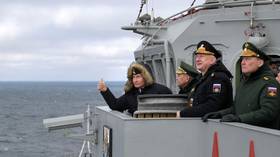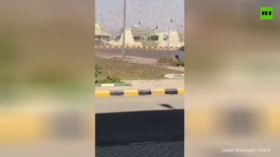As London seeks to boost military spending, Telegraph obliges with ludicrous claims that Russia has military advantage over NATO

“The Russians are coming!” They’re not, of course, but more and more commentators are saying that if they ever do, there will be nothing that can stop them. Western militaries are now so weak that Moscow will crush them like ants.
Anybody who thinks about this for an instant will realize that it’s palpable nonsense. But it reflects a longstanding habit of threat inflation that for years has distorted sensible discussion of the international security environment.
It’s said that you can only be certain of two things – death and taxes. But there’s a third: the world is always becoming more dangerous. Whatever the reality, the analysis of Western security experts is nearly always the same: “the threat is growing, spend more on defence, and intervene more around the world to stop the rot before it’s too late.”
Also on rt.com Moscow accuses NATO boss Stoltenberg of lying about Russian refusal to speak to alliance, says he ignored Russian proposalsThus, Sky News journalist James Morrow caused headlines this week by stating that, “These are dangerous times and thanks to Joe Biden, they’re getting a lot more dangerous.” This followed four years in which we were repeatedly told that the world was becoming ever more dangerous thanks to Donald Trump’s maverick foreign policy. And that in turn followed eight years of Barack Obama, when, as Forbes magazine put it: “The world is becoming frighteningly more dangerous because the Obama Administration has made it so.” And so on and so forth, as far back as you care to look.
If the basic concept of growing danger remains constant, the reason for it keeps changing. After the collapse of communism, a new threat had to be found to keep people afraid, but Robert Kaplan soon presented one in a famous 1994 article in The Atlantic entitled “The Coming Anarchy.” Kaplan predicted that environmental stress and other factors would cause a wave of successive state collapse throughout the globe, which would eventually wash up on Western shores. Almost 30 years later, it’s yet to happen.
Perhaps because it was a bit far-fetched, the spectre of worldwide state failure was soon supplanted by another threat: ethnic conflict. When that failed to spread far beyond the borders of the Balkans, a new danger appeared – rogue states. After 2001, however, terrorism became danger No. 1. The failure of the War on Terror, though, produced something of a rethink. A new threat was needed.
Also on rt.com ‘Worrying trend’: London seeks to exclude Moscow from European security system while it cozies up to America, says Russian envoyEvents in Ukraine provided one – Russian hybrid warfare, a gloriously ill-defined term that turns almost everything into a security threat. Unfortunately for the military industrial complex, however, it’s hard to use hybrid warfare to justify high levels of military expenditure. For that you need an enemy that has some real firepower at its disposal. And so it is that hybrid warfare is now somewhat passé. Instead, we are back where we were in the Cold War, elevating the conventional military might of Russia as the primary danger to world peace.
An example is the British government’s new defence review, which calls Russia “the most acute threat to our security.” This follows a recent complaint by the UK’s House of Commons Defence Committee that in a war versus Russia, British tanks would be “outgunned,” while an “artillery duel” would be “likely to end one way – and not necessarily to the British Army’s advantage.”
Pouring fuel on the fire, on Monday Britain’s leading conservative newspaper, The Daily Telegraph, ran an alarmist story with the title “China and Russia’s military arsenals are alarming in scale – but how would they perform in combat?” Answering that question, authors Roland Oliphant, Nataliya Vasilyeva, and Sophia Yan claim that “Russia’s army is battle hardened.” In addition, they say, Russia “boasts the world’s largest tank fleet, with over 15,000 tanks in its armoury” as well as 900,000 troops, whereas “NATO is estimated to have no more than 10,000 troops near the Russian border.”
It sounds scary … until you check the facts. The Telegraph is being more than a little disingenuous. Only a small fraction of the Russian army has acquired combat experience in foreign operations. Thus, as a whole, the armed forces can’t be called “battle hardened.”
Also on rt.com Unable to win on battlefield, West is now waging ‘mental war’ against Russian civilization, Moscow’s Ministry of Defense claimsThe 900,000 troops cited by the Telegraph include all arms of service – army, navy, air force, strategic rocket forces, command and support, and so on. Many of these are nowhere near NATO’s border, but are spread across the entire 11 time zones of the Russian Federation. Moreover, the figure of 10,000 NATO troops ignores the entirety of the 150,000-strong armed forces of Poland and the three Baltic states, all of which border Russia.
The International Institute of Strategic Studies’ Military Balance lists Russia as having not 15,000 tanks, as The Daily Telegraph claims, but 2,840 (there are another 10,000 in storage, but many of them have been there for 30 years and one may doubt if they are in working condition). Of the 2,840 in service, most are aged T-72s and T-80s. The Russian army isn’t quite what it’s made out to be.
This is not to say that the Russian military has not invested in modernization in recent years. New equipment, like the Armata tank and the Avangard and Zircon hypersonic missiles, is now coming into service. Some of this is, indeed, superior to anything at present in NATO’s armoury. But there is little of it. The bulk of the Russian armed forces still operates Soviet-era machinery.
The most likely use for this equipment would not be a war against NATO, but in Ukraine. In recent weeks, there has been talk of the possibility that the Ukrainian government might launch an offensive against the rebel republics in Donbass. Were that to happen, one might expect a Russian response. In that event, it would be likely that the Russian army would destroy its Ukrainian counterpart in short order. But it is a big step from there to defeating NATO. Any attempt to do so would be suicidal.
The Russian military is much better than it was 20 years ago. But pretending that Russia has a military advantage over NATO is scaremongering, pure and simple. Do not be fooled.
Like this story? Share it with a friend!
The statements, views and opinions expressed in this column are solely those of the author and do not necessarily represent those of RT.
The statements, views and opinions expressed in this column are solely those of the author and do not necessarily represent those of RT.














